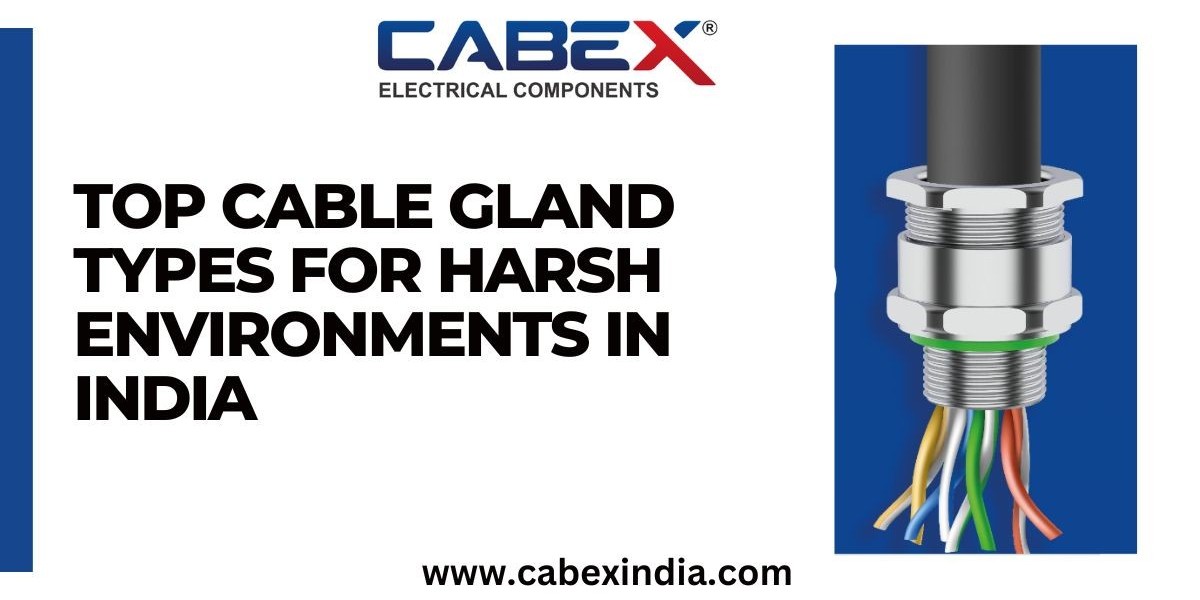Introduction
In industrial applications, especially in harsh environments, it’s crucial to ensure that every component of the electrical installation is built to withstand demanding conditions. Cable Gland Types are one such component that plays a vital role in protecting cables from environmental damage, ensuring the longevity and safety of the overall installation. These harsh environments could include areas with extreme temperatures, moisture, dust, chemicals, and even potentially explosive atmospheres.
In India, with its vast range of industries—ranging from petrochemical plants to heavy machinery and mining sectors—selecting the right cable gland is critical. This article will explore the top cable gland types suitable for harsh conditions, their key features, and why they are the ideal choice for these challenging environments.
Understanding Harsh Environments
Before diving into the types of cable glands, let’s first define what constitutes a "harsh environment." These environments typically present extreme conditions that can cause severe wear and tear on electrical components, including:
- High temperatures: Industrial sectors like foundries, steel plants, or chemical processing units often have temperatures that exceed 100°C.
- Chemical exposure: Environments like chemical factories or refineries expose components to corrosive chemicals.
- Water and moisture: Marine environments, wastewater treatment plants, and outdoor installations face constant exposure to water, requiring waterproofing.
- Explosive atmospheres: Industries like oil & gas, mining, and chemical processing must consider explosion-proof equipment to mitigate risks from flammable gases or dust.
- Dust and debris: Cement factories, coal mines, and agriculture industries generate a lot of particulate matter that can damage cables if not properly sealed.
Top Cable Gland Types for Harsh Environments
1. Explosion-Proof (Ex) Cable Glands
- Description: Specifically designed for use in hazardous locations where flammable gases, vapors, or dust are present.
- Material: Usually made from brass or stainless steel for durability and corrosion resistance.
- Key Feature: Prevents sparks from causing explosions by sealing off cables in environments with combustible materials.
- Applications: Oil refineries, chemical plants, mining, and other industries with a risk of explosion.
- Why It’s Ideal: These glands meet strict safety standards (like ATEX, IECEx) and are crucial for protecting both the cables and the environment in high-risk areas.
2. IP68 Waterproof Cable Glands
- Description: Rated for high levels of water ingress protection, IP68 cable glands can withstand complete submersion in water.
- Material: Made from durable plastic (like polyamide) or metal (brass or stainless steel).
- Key Feature: Offers superior waterproofing for cables exposed to moisture, ensuring the integrity of the electrical connection.
- Applications: Marine industries, outdoor electrical installations, and wastewater treatment plants.
- Why It’s Ideal: In environments with high moisture content or where cables may be exposed to water, IP68-rated glands ensure that there is no water ingress, protecting the cables from short circuits or corrosion.
3. EMC Cable Glands (Electromagnetic Compatibility)
- Description: Designed to protect cables from electromagnetic interference (EMI), ensuring that electrical signals remain unaffected.
- Material: Usually made from nickel-plated brass.
- Key Feature: Provides grounding and shielding to prevent the transfer of electrical noise.
- Applications: Telecommunications, data centers, and areas with sensitive electronics.
- Why It’s Ideal: In environments with high electrical noise, such as data transmission centers or areas with multiple electrical devices, EMC glands ensure the smooth operation of equipment without signal disruption.
4. Corrosion-Resistant Cable Glands
- Description: These glands are specifically designed to resist corrosive environments, such as those where chemicals or saltwater exposure is a concern.
- Material: Commonly made from stainless steel or brass with protective coatings.
- Key Feature: Highly resistant to chemical exposure, ensuring that the glands do not degrade over time.
- Applications: Chemical processing plants, offshore drilling, and marine industries.
- Why It’s Ideal: In environments where chemicals or corrosive substances are present, these glands offer long-lasting protection against deterioration, which helps prevent failures in electrical systems.
5. High-Temperature Cable Glands
- Description: Engineered to withstand extreme temperatures, these glands can operate in environments that reach over 100°C.
- Material: Typically made from stainless steel or special high-temperature-resistant materials.
- Key Feature: Can handle high thermal stress without deforming or losing their sealing properties.
- Applications: Steel plants, foundries, and industrial ovens.
- Why It’s Ideal: For industries exposed to high heat, such as manufacturing plants and industrial furnaces, these cable glands ensure that electrical connections remain intact despite high thermal fluctuations.
Factors to Consider When Choosing Cable Glands for Harsh Environments
- Material: Stainless steel and brass are often preferred due to their resistance to corrosion and durability in tough conditions.
- Ingress Protection (IP) Rating: A higher IP rating (like IP67 or IP68) ensures better protection against dust, water, and other external elements.
- Temperature Range: Select glands that are rated for the temperatures they will be exposed to. For high-temperature environments, choose glands that can operate at 100°C or higher.
- Certification: In hazardous areas, always ensure that the cable glands are certified according to international standards like ATEX or IECEx.
- Cable Type: Armored or unarmored cables require specific glands. Armored cable glands are more robust and offer additional mechanical protection.
Importance of Using the Right Cable Gland in India’s Industrial Sector
India’s industrial sectors are diverse, encompassing everything from power generation and petrochemicals to mining and marine applications. Harsh environments are common, and using the right cable gland not only ensures the longevity of electrical installations but also guarantees safety. Cable failures in these environments can lead to significant downtime, financial losses, and in the worst cases, accidents. By choosing the appropriate cable gland for the specific conditions, industries can mitigate risks and enhance operational efficiency.
Frequently Asked Questions (FAQs)
1. What is the purpose of using explosion-proof cable glands? Explosion-proof cable glands are used in hazardous environments where there is a risk of flammable gases or dust. They prevent sparks from escaping the cable system, thus preventing potential explosions.
2. What does an IP68 rating mean for cable glands? An IP68-rated cable gland provides complete protection against dust and can withstand prolonged immersion in water. This makes it ideal for underwater or highly humid environments.
3. Can stainless steel cable glands resist corrosion? Yes, stainless steel cable glands are highly resistant to corrosion and are often used in industries where exposure to chemicals or saltwater is common.
4. What is the difference between armored and unarmored cable glands? Armored cable glands are designed to handle cables that have an extra protective layer (armoring) for mechanical protection. Unarmored cable glands, on the other hand, are used for cables without this extra protection.
5. Are high-temperature cable glands necessary for steel plants? Yes, high-temperature cable glands are essential in steel plants where extreme heat is a constant factor. These glands ensure that cables and connections remain intact under high thermal stress.
Conclusion
Choosing the right cable gland is critical in harsh environments to ensure safety, reliability, and longevity of electrical installations. From explosion-proof to corrosion-resistant glands, each type plays a crucial role in different industries across India. Proper selection based on the specific environmental challenges helps industries operate smoothly, reduce downtime, and protect their workforce and equipment from potential hazards.









